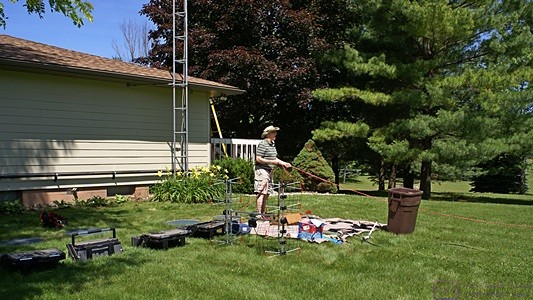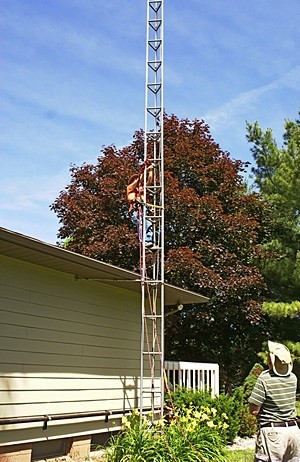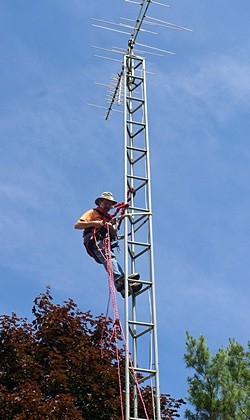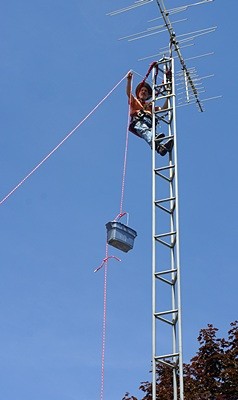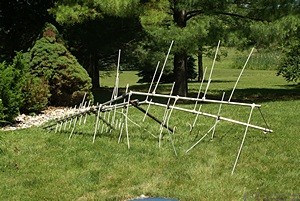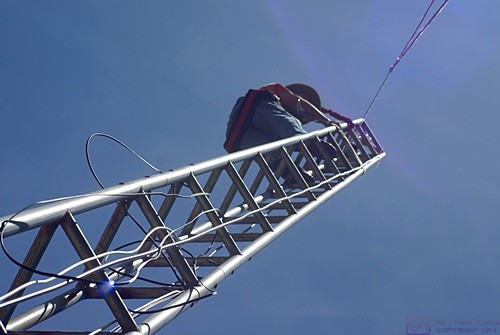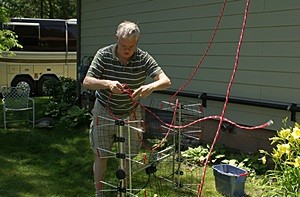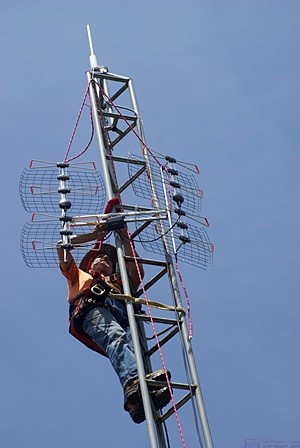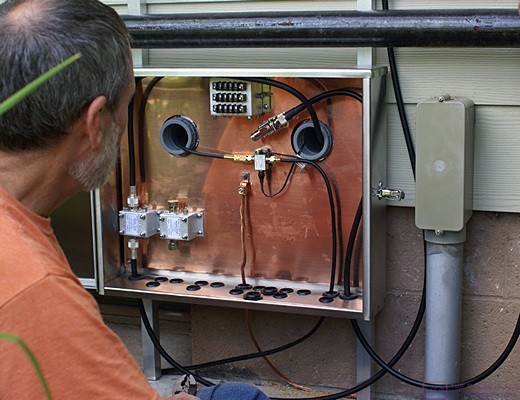Brighton Honda called yesterday in the afternoon to get permission to do additional work on my car. Since we plan to keep the car for a while, and then perhaps give it to our son, it was the kind of work that needed to be done regardless of the costs. They called back later to indicate that they would not have it aligned before closing time. That was fine with us as it would have been inconvenient to impossible for us to get there by 6 PM to pick it up. Linda told them to call in the morning when it was ready.
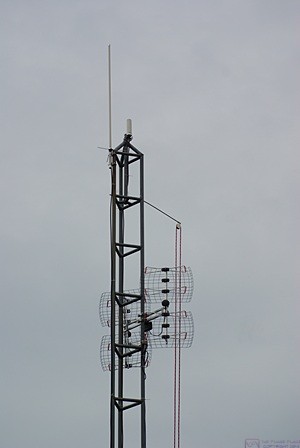
The top of the 40-foot tower from the WNW showing all of the antennas and the pulley with the haul rope. The weather had definitely deteriorated from the day before.
It is amazing how attuned we become to routine sounds and how sensitive we are to non-routine ones, even (especially?) while sleeping. So it was last night that I was suddenly aware that one of our cats was making a repetitive sound that was unusual. I turned on my flashlight, hoping to not disturb Linda, and got out of bed. Both cats were hunched down on the floor on Linda’s side of the bed with Jasper in front. He was the one responsible for the sound and the reason was next to his head and about 3 inches away; a little dark gray mouse.
My first thought when I see one or both of the cats with a mouse next to them rather than in their mouth is that it is dead but that was not the case. This mouse was alive and apparently not injured. I have seen this behavior before in which the mouse basically “plays dead” and the cats leave it alone but watch it carefully. Mice seem to know that cats are triggered by movement and that if they sit very still the cats just sit there and guard them. It was 4:30 AM and I was not fully awake so I do not recall the exact sequence of events, but the mouse somehow ended up in our master bathroom. I do not recall what I did with the cats but I think I went and got a box with high sides and tried to get the mouse to go in it and it made a run for it towards the bathroom. Linda was awake by this point so she got a towel for me. I went in the bathroom and used the towel to block the gap under the door and prevent the little critter from getting back into the bedroom while I tried to get it into the box. I was unsuccessful and it managed to find a place to hide in the hot water baseboard radiator.
Linda got one of the live traps we recently purchased and baited it with the recommended saltine and peanut butter. We set the trap near the radiator, turned out the bathroom light, shut the door, and tried to plug the gap with the towel from the outside, figuring we would deal with the mouse in the morning. Juniper kept pawing at the towel and pulling it back from the door so we put both cats out of the bedroom and shut the door. They found that confusing as they sleep with us and generally have the run of the house. One or both of them pawed at the door meowing to get back in for quite a while. It wasn’t the best night’s sleep we have had and the timing was unfortunate given the hard day of tower work.
Brighton Honda called at 8:01 AM to let us know the car was ready. Hello, I’m awake now! I checked on the mouse and it was now safely tucked away on top of the radiator fins inside the housing where neither the cats nor I could get to it. We decided to leave the live trap in place, sealed the gap under the door, and kept the bedroom door shut to keep the cats out.
I had planned to drive to Isringhausen’s U.S. headquarters in Galesburg, Michigan today but first we had to get my car. As long as we were headed that way we decided to go to the Brighton Panera for coffee, but had toast and juice for breakfast at home before we left.
The 100,000 mile service is extensive and includes changing the spark plugs. Beyond the routine service items the Element needed a new ball joint and tie rod and had a stuck brake caliper pin that had to be repaired. Given the front end work I also had them align it. Butch and I rebuilt the front brakes last year so I was surprised that there was an issue with them, but the car has been towed and driven in some harsh environments since then so that may have been a factor.
The Panera at Grand River Avenue and I-96 is not one of our favorites. More often than not we end up with coffee grounds in our cups and the bathrooms are not maintained as they should be. Today was not the first time we have been to this location that the men’s restroom was out of toilet paper. It is also often freezing cold inside the restaurant and today was no exception. The weather was overcast and a bit gloomy but the outside temperature, while not warm, was much more comfortable than inside. We were also unable to connect to their Wi-Fi signal, which is generally useable. That’s pretty basic stuff to not be able to get right and falls squarely on local management in my opinion.
While we drank our coffee I called Rick Short at ISRI to make sure he would be in but I got his voice mail again. I asked for a call back but never got one so I did not make the trip to Galesburg. Apparently they have better things to do than be of assistance to me. I only want to buy one chair, not a fleet of chairs, so I understand my relative unimportance, but I don’t like it just the same. We decided to spend the day at home completing the work from yesterday, which had made a mess throughout the house.
One of the things we needed to do was register our cellular booster system. Given that it is a five band device I was not clear on whether we had to register it only with Verizon or with all of the carriers. I called the company we bought it from, Cellular Solutions, and talked to Judy who said we only had to register it with the carriers we personally use. For us that is Verizon Wireless. Registration was via the Verizon Website and was simple enough. It did, however, require me to log in to our My Verizon account and navigate through a couple of screens to a page where we could enter the information from the label on the box. The serial number was on two peel off tags, so one of those went on the booster and the other one went in the manual.
With the unit registered I turned the power switch on and watched the ‘Alert’ lights all go solid yellow. As I mentioned in yesterday’s post solid yellow lights are not described anywhere in the manual. I called Cellular Solutions back and said I had a technical support question. The woman on the phone took my name and number and said someone would call me back.
Since I was apparently taking care of phone chores I decided to call Universal Towers and inquire about their B-30 base. The woman who answered the phone never gave her name but was able to answer some questions. She indicated that their base might or might not be compatible with older Heights Tower products, depending on exactly which product I had, and that I would have to talk to the owner, Bill, who wasn’t there at the moment. She did know that the outside-to-outside measurement of the legs on a B-30 base was 30 inches and the base cost $290. She also told me that the larger bases, like the B-30, consisted only of the three rods with the mounting yokes on top; the three rods were not otherwise connected together in any way. She also confirmed that the ‘U’ shaped yokes at the top of the base rods were welded on and not adjustable. The normal installation procedure involved connecting them to the bottom of the legs of the first section of the tower, setting them in the hole as the concrete is poured, and adjusting them by moving them around until the legs of the tower were plumb. That sounded to me like a process where a lot could go wrong and not be repairable.
I pulled a 75 ohm coax out of the ceiling of the basement yesterday. We laid it out in the basement to see how long it was and it looked to be at least 60 feet. Linda suggested we test it before running it through the basement ceiling which was a very sensible idea. I unplugged the power adapter for the TV amplifier power inserter, detached the coax that feeds the TV in the bedroom, attached the downstairs cable, and connected the other end to the basement TV set. Linda set up the TV for Antenna input, did an All Channels scan, and got the same stations we got yesterday, minus a couple.
In spite of what appeared to be acceptable performance I decided I wanted a new coax cable and Linda wanted to return three of the ropes I bought at Lowe’s but never used. She found the receipt and we went to Lowe’s. They had a good quality RG-6 quad-shield coax (75 ohm) in various lengths including 50 feet, which is what I needed. At the register I decided to buy two more 40 pound bags of solar salt. I am not an impulse shopper as a rule but their supply of Morton Solar Salt was very low and stocking up seemed like a good idea.
We stopped at Teeko’s to order coffee. Mary took our order and rang it up; one pound each of the three different half-caff blends that have become our standard. We took note of the fact that the Bennigan’s restaurant building on the northwest corner of Grand River Avenue and Latson Road was gone and a sign said a Panera would be coming soon to that location. We didn’t say anything to Mary, but that cannot be good news for Teeko’s. We will continue to buy our custom roasted beans at Teeko’s as long as they are open but it is going to be difficult for them to compete with a $2.25 cup of bottomless coffee, free Wi-Fi, a restaurant, a bakery, drive through service, and ample parking with great access to I-96.
When we got home I checked the live trap in our master bathroom and we had captured the mouse. We took the trap to the northeast corner of the property, towards our neighbor’s pond, and set it free. It did not want to leave the trap and I had to encourage it to go. Once it hit the ground, however, it scampered away looking for a place to hide.
We then worked on running the new coax from the basement TV to the sump pump room above the suspended ceiling. I disconnected the power inserter for the amplifier and disconnected the old coax we had tested earlier. I notched a ceiling panel at the corner of a boxed support column behind the basement TV to allow the ceiling tile to go back into place around the coax. We then installed one of the wire channels to contain and hide the coax from the ceiling down to the TV set and connected it to the back of the set.
In the sump pump room I attached the coax from the cable entry box (CEB) to the input of the new 1-to-2 signal splitter. I attached the coax for the bedroom TV to one output from the splitter and the coax we just ran to the other output. I mounted the splitter on the wall of the sump pump room and secured the cable coming from the CEB to the ceiling. I then plugged the power supply for the power inserter back in to an AC outlet. Linda scanned for channels and verified that everything was working correctly. We then installed the other wire channel alongside the trim on the bedroom doorwall to route and hide the cable coming up from the basement.
I continued to fuss with the cell phone booster gain settings. We had not gotten the promised return phone call from Cellular Solutions Technical Support so I called them. I got Judy again and explained what I was seeing with the solid yellow lights. She checked with her tech support people and they said the manufacturer (SureCall) told them the solid yellow was the same as the blinking yellow; that the booster was adjusting the gain and it was “normal.” The manual says that normal is when the light is off, so I’m not sure I buy this explanation, but based on that I left the booster turned on.
With all of that done we started cleaning up the tools and materials we had scattered over two floors of the house. I decided that was also a good time to start a load of laundry, although it was actually rather late in day for that. I did three loads by the time I was done and it was sometime after 10:30 PM before the last load was dry. I needed to be up at 7 AM to be at breakfast in South Lyon at 8 AM as our SLAARC group would start setting up for the ARRL Field Day event at 9 AM.
